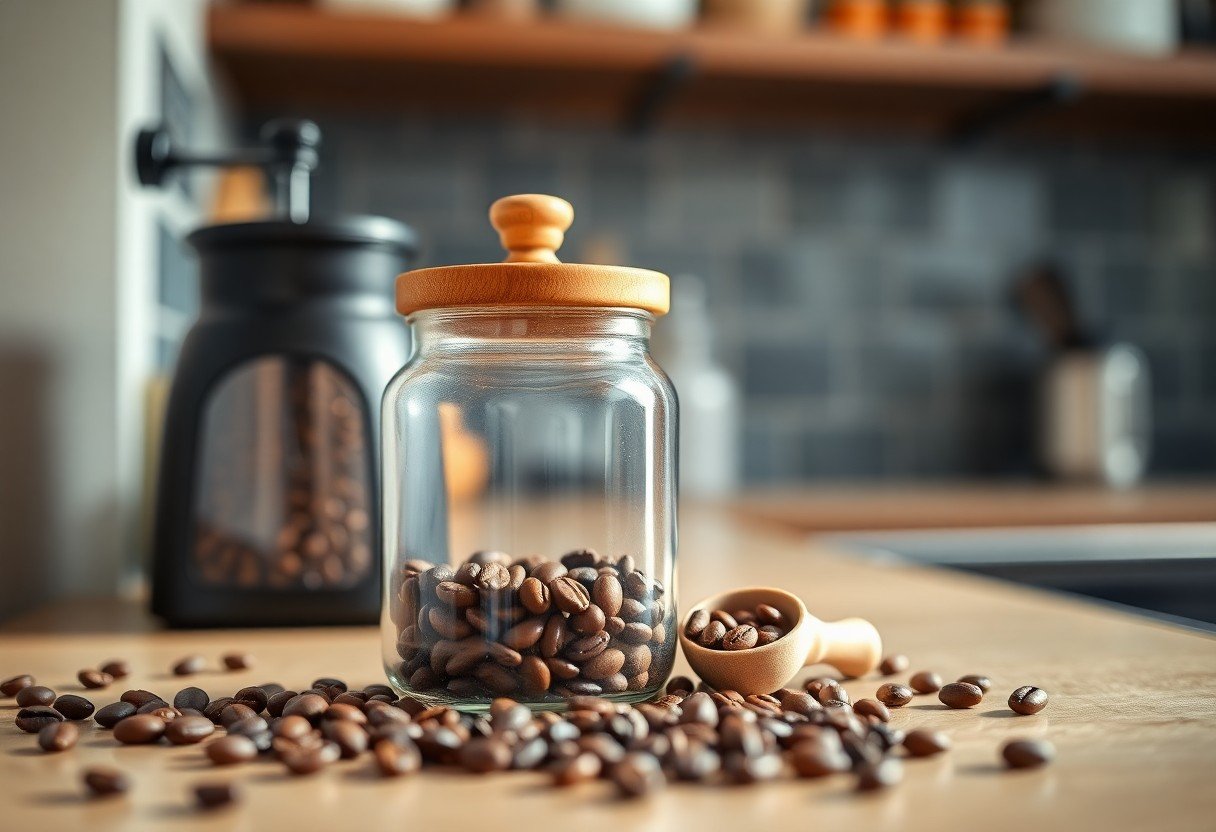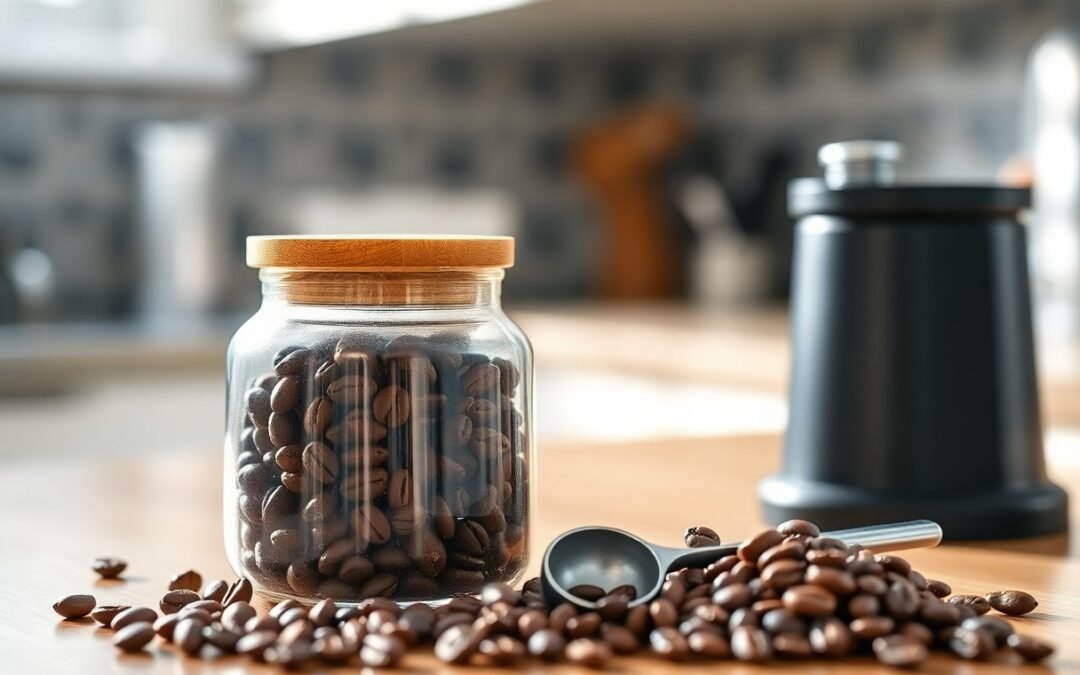Coffee lovers know that the way you store your beans can make a significant difference in flavor. To ensure your coffee maintains its rich aroma and robust taste, it’s vital to adopt proper storage techniques. In this guide, you will learn effective methods to keep your coffee beans fresh, preventing them from exposure to elements that can diminish their quality. With these practical tips, you can savor the delightful experience of a perfectly brewed cup at any time.
The Science Behind Coffee Bean Freshness
Understanding what keeps coffee beans fresh involves a deep probe the intricate chemistry at play. Several factors affect the flavor profile and aroma of coffee, most notably volatile compounds and oxidation. Fresh coffee beans contain imperative oils and aromatic compounds that contribute to their delightful flavors. However, these components can deteriorate over time, leading to a less satisfying cup. By grasping these scientific aspects, you can implement better storage practices to preserve that freshly roasted experience.
Understanding Volatile Compounds
Volatile compounds are the aromatic molecules responsible for the unique fragrances and flavors in coffee. These compounds evaporate quickly, which means that exposure to air can cause significant loss over time. When you grind your beans, you increase the surface area exposed to air, accelerating the evaporation process. Thus, storing your beans in an airtight container is vital for maintaining those fragrant oils, which play a critical role in your coffee’s overall taste profile.
The Role of Oxidation
Oxidation occurs when coffee beans react with oxygen, leading to the deterioration of flavor and aroma. As soon as coffee is exposed to air, oxidation begins, resulting in rancid flavors and a flat taste. The process is exacerbated by light and heat, which can further break down flavor compounds. Ideally, beans should be kept in an opaque, airtight container, away from direct sunlight and heat sources, to slow down oxidation and extend their freshness.
Oxidation is a natural chemical reaction that can significantly alter the quality of your coffee. Within just a week of exposure, even the best coffee beans can lose many of their desirable flavor notes. For instance, volatile compounds like aldehydes and esters, responsible for fruity and floral notes, degrade quickly under oxidizing conditions. Research indicates that coffee stored in sealed, dark containers can maintain its flavor profile for up to several weeks longer than those left exposed. Therefore, minimizing oxygen exposure not only preserves the integrity of your coffee but ensures a vibrant, aromatic brewing experience with every cup.

Essential Storage Conditions for Optimal Preservation
Ensuring your coffee beans retain their rich aroma and exquisite flavor hinges on maintaining the right storage conditions. Proper temperature, humidity, and light levels all play a significant role in preserving the freshness of your beans. Without attention to these factors, your coffee can easily lose its desirable qualities, leading to a disappointing brewing experience.
Temperature Control: The Invisible Enemy
The ideal storage temperature for coffee beans ranges between 60°F to 70°F. Higher temperatures can accelerate the degradation process, causing your beans to lose flavor over time. Below is a breakdown of how temperature affects your beans:
| Temperature Range | Impact on Coffee Beans |
| Above 75°F | Accelerates oils and compounds breakdown, leading to stale taste. |
| 60°F – 70°F | Ideal range to preserve flavor and aroma. |
| Below 60°F | Risk of condensation if brought back to room temperature, impacting freshness. |
Humidity Levels: The Balance of Moisture
Humidity plays a vital role in coffee preservation. Your beans should be stored in a cool, dry environment, ideally with humidity levels between 30% to 50%. Higher humidity can lead to mold growth, while very low humidity may result in dry, brittle beans. Finding that sweet spot is necessary for keeping your beans fresh.
Excess humidity can not only compromise the texture of your coffee beans but also promote the growth of mold and bacteria, which ruin the flavor. Conversely, if the air is too dry, beans may lose their necessary oils and aromas, leading to a flat taste. Utilize hygrometers to monitor humidity levels, and consider airtight containers designed to mitigate moisture fluctuation, striking the right balance for optimal coffee preservation.
Containers that Keep Flavor Intact
The right containers can make all the difference in maintaining your coffee’s rich aroma and taste. Tightly sealed options that limit exposure to air, moisture, light, and heat are crucial for preserving freshness. Look for materials that are specifically designed to offer optimal protection, allowing you to enjoy your brews at their best for as long as possible. Investing in quality containers means you can savor every cup without the worry of stale or diminished flavors.
Airtight Options: Choosing the Right Materials
Airtight containers can be made from a variety of materials, but glass, stainless steel, and ceramic stand out as top picks. Glass containers with rubber seals provide a non-reactive surface, stainless steel offers durability and insulation, and ceramic comes with a classic aesthetic. Ensure the chosen container tightly seals to prevent air from entering, as this is vital for keeping your coffee beans’ flavors intact and prolonging their shelf life.
Light Prohibition: The Dark Side of Brewing
Light exposure can severely impact the quality of your coffee, degrading the aromatic compounds that provide its unique flavor profile. Keeping your beans in a clear container may seem appealing, but it invites harmful UV rays that can spoil freshness. Instead, opt for opaque materials that block light, safeguarding your coffee from any negative effects while maintaining its rich and aromatic character.
Research from coffee experts has shown that light can accelerate the oxidation process, leading to the loss of crucial oils responsible for flavor. This means that a beautifully packaged or transparent container might look good on your shelf, but it compromises the taste experience. Aim for containers that completely shield your beans from light, ensuring your next cup bursts with the freshly-roasted aroma and that delightful taste you’ve come to love. Enjoying exceptional coffee starts with smart storage choices that prioritize what matters most: flavor and freshness.

The Timing Paradox: When to Purchase and Store
Timing is integral to maintaining the freshness of your coffee beans. Purchasing coffee shortly after it has been roasted guarantees optimal flavor, as it peaks within a few days to a week. However, you’ll need to consider your consumption rate. Buying in bulk might seem appealing, but understanding when to store is key to avoiding staleness and preserving taste. Finding that sweet spot between purchasing fresh beans and consuming them requires careful planning based on your brewing habits.
Batch Sizes vs. Freshness
Balancing batch sizes with freshness is vital for keeping your coffee enjoyable. If you regularly drink coffee, opting for smaller batches ensures you consume beans at their peak flavor. However, if you don’t drink it as often, consider finding a middle ground to prevent wastage while allowing for freshness. Purchasing just enough beans for a week or two can help retain that aromatic quality you crave.
Frequency of Use: Is Bigger Better?
Your frequency of coffee consumption significantly influences how much you should buy at once. Buying larger quantities might seem economical, but if you find that your intake varies day-to-day, those beans can lose their flavor faster than anticipated.
For those who enjoy coffee daily, a significant batch might be manageable. Yet, if your habits fluctuate or you’re not a daily drinker, buying larger amounts could lead to stale beans within weeks. A good rule of thumb is to purchase enough for about two weeks of use; this way, you can maintain freshness without compromise. Monitor your brewing habits and adjust your purchases accordingly to keep your coffee experience satisfying with every cup.
Strategies for Maintaining Aroma Over Time
To truly preserve the delightful aroma of your coffee beans, effective strategies should be integrated into your coffee storage routine. Begin by minimizing the exposure to air, light, heat, and moisture, all of which can compromise the flavor profile. Employing a consistent routine for storing and handling your beans can significantly help maintain freshness. Additionally, adhering to proper storage techniques—like using durable, opaque containers—ensures that your coffee retains its enticing aroma over an extended period.
Best Practices for Opening and Closing Bags
Each time you open a bag of coffee beans, their exposure to air increases, which can deteriorate their freshness. To mitigate this, always reseal the bag tightly after each use, using clips or vacuum-sealing options when possible. Try to consume your coffee within two weeks of opening, as this aids in preserving the aromatic compounds. Avoid shaking the bag since this can introduce moisture, which further deteriorates bean quality.
Alternative Methods: Freezing and Vacuum Sealing
For long-term storage, freezing coffee beans or using vacuum sealing techniques can be highly effective. If you opt to freeze your beans, divide them into smaller portions and store them in airtight containers to reduce exposure to air upon retrieval. Vacuum sealing removes oxygen from the packaging, which helps maintain the aroma and quality of the beans over several weeks or even months.
Freezing and vacuum sealing offer an exceptional way to extend the life of your coffee beans without degrading their important flavors. When freezing, ensure to use freezer-safe, airtight containers or bags to prevent freezer burn and contamination from other odors. As a guideline, only take out the amount you need at a time; repeatedly thawing and refreezing beans can lead to significant loss of aroma. Vacuum sealing can be performed with home appliances designed for this purpose and effectively locks in flavor while preventing moisture infiltration, making it an ideal solution for coffee enthusiasts and frequent brewers alike.
Summing up
Considering all points, you should prioritize proper storage to maintain the aroma and taste of your coffee beans. Use airtight containers made of opaque materials to shield your beans from light, air, and moisture. Store your container in a cool, dry place away from heat sources. By following these simple steps, you can ensure that your coffee remains fresh and flavorful, enhancing your daily brewing experience.
Q: What is the best way to store coffee beans to maintain their freshness?
A: To maintain the freshness of your coffee beans, store them in an airtight container in a cool, dark place. A vacuum-sealed bag or a container with a one-way valve is ideal. Avoid exposure to light, moisture, and heat, as these factors can accelerate the degradation of flavor and aroma. Keeping your coffee beans in the pantry away from the stove or refrigerator is generally the best practice.
Q: Should I refrigerate or freeze my coffee beans for long-term storage?
A: While refrigerating coffee beans is not recommended due to the potential for moisture and odors, freezing can be an effective method for long-term storage if done properly. If you opt to freeze your coffee, divide your beans into smaller portions to avoid repeated thawing and freezing, which can negatively impact quality. Use an airtight container or vacuum-sealed bag to prevent moisture buildup. When you’re ready to use them, allow the beans to come to room temperature before opening the container to avoid condensation.
Q: How long can I keep coffee beans stored while still ensuring quality taste and aroma?
A: Unopened coffee beans can maintain their optimal flavor for about 6 to 12 months when stored properly. Once opened, it’s best to consume them within 2 to 4 weeks for the best taste. Make sure to reseal the container tightly after each use. If you notice off flavors or a stale smell, it’s a sign that the beans have lost their freshness, and you may want to replace them.

